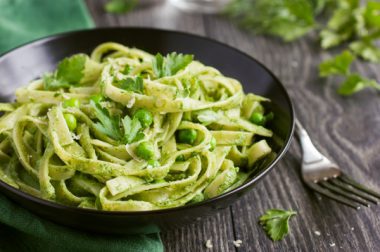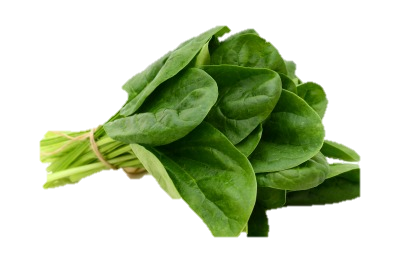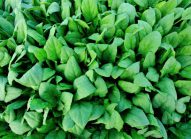Recipes we love
See all recipesSpinach and zucchini tart
A vegetable tart to share with friends. Spinach and zucchini provide some essential vitamins (beta-c...
Spinach soup with risonis
With grated cheese, you have a whole spinach meal and a good dinner that you can complete with a gre...
Eggs and spinach
An ideal dish for dinner, which brings the 3 essential vitamins that contribute to the normal functi...
Health
benefits
Popeye’s vegetable
Spinach is one of the treasures of the plant world. It is one of the vegetables with the highest iron content (for cognitive function, red blood cells, the immune system, energy, and fatigue reduction) and accounts for a significant portion of recommended daily value (40% for a 200-g portion for a man)! Now we understand why Popeye is always winking!
Did you know? Cooked spinach is more nutritious than raw spinach and contains more antioxidants (provitamin A). A portion of cooked spinach is larger than one of raw spinach, supplying you with more vitamins and minerals!
Spinach is also:
- a source of vitamin B9 (for cellular renewal, particularly important for pregnant women for fetal development, for growing children, and for convalescents).
- a source of vitamin C when raw (for the immune system, collagen formation, energy, the nervous system, and iron absorption, and fights fatigue)
- a source of vitamin E (for protecting tissues)
- a source of provitamin A when cooked or frozen (for vision, iron metabolism, the immune system, and skin health)
- a source of magnesium when raw (for the nervous system, muscular function energy, fatigue reduction, and teeth and bone health)
- a source of calcium when cooked (for teeth and bone health, muscular contraction, blood coagulation, and energy)
- a source of fiber (for regularity of bowel function and satiety)
Nutritional
composition
When is the right time to eat it?
All year.
Spinach is available year-round, even if it is somewhat less plentiful in July and August, as it does not grow well in extreme heat
Vegetable patch
or urban balcony?
Spinach is an herbaceous annual that grows well in cool soil rich in clay, in partial shade.
To learn everything you need to know about growing spinach, read the page on growing advice.
Choosing and storing spinach
To choose your spinach well:
- The leaves should be dark green, shiny, and crisp, and should be neither wilted nor spotted.
To properly store your spinach:
- In the refrigerator: One to two days at most in the vegetable drawer
- In the freezer: several months if it is purchased frozen; after blanching if it was purchased fresh.
Tips
and tricks
How to prepare spinach
Set aside thicker leaves for cooking and the more tender leaves for eating raw.
Carefully sort through the leaves one by one, removing the stems and stalks. There will be a large quantity of stems to throw away, especially if the leaves are large. (Plan for large quantities if you are cooking the spinach: at least 500 g for a cooked side dish for two people, and 200 g for a raw salad for two people).
Wash the spinach thoroughly, several times if necessary, to remove all traces of soil.
Whether fresh or frozen, spinach should be cooked quickly, in just a few minutes, to preserve the integrity of the leaves. Next, plunge it into an ice water bath so it maintains its beautiful green color. Then move to the next step of your recipe.
Spinach goes well with…
Raw: Young spinach leaves are delicious in salads, especially with other young salad greens, apples, smoked fish, fresh cheese, hazelnuts, and other shellfish. Plan on 100 g per person.
Cooked: Cooked spinach goes perfectly with cream (as in the well-known creamed spinach). It also goes very well with eggs, fish, poultry, and roasted white meats.
Did you know? In cooking, the word ‘Florentine’ designates dishes in which spinach is paired with the main ingredient. We owe this name to Catherine de Medici, born in Florence, in Italy, and queen of France from 1547 to 1559. It is said that she loved spinach so much that she required her chefs to travel everywhere with her to cook her favorite dishes.
Can everyone eat it?

Young children
Spinach is one of the first vegetables offered to infants. Spinach can be eaten from age six months on, first in purée and soup form. For older children who give it the cold shoulder, add it to a purée or a flan, or even a stoemp (a traditional Belgian dish with potatoes mixed with a variety of vegetables, all in a purée).
And everyone else
Spinach is great for people of all ages, with the exception of those who suffer from or are at risk for urinary tract stones. Spinach contains a large quantity of oxalates, compounds that favor the formation of stones. People in that situation should not eat too much of it or should ask the advice of a health professional.
See plenty of other tips for encouraging children to eat vegetables
Where does it come from?
Origins
China is the biggest spinach producer in the world, followed by the United States and Japan. France is the biggest European producer, followed by Belgium and Italy. The German are the biggest consumers of the vegetable.
Varieties
Spinach is the number two frozen vegetable eaten in France. Most of the time it is eaten plain or with cream.



 Bean sprouts
Bean sprouts  Parsley
Parsley  Vegetable garden: growing chestnuts
Vegetable garden: growing chestnuts 










